July 2013
USS Indianapolis and Jaws
31/07/13 16:07 Filed in: History
“Man goes into the water…….shark is in the water…….” One of the famous scenes was when Captain Quint in Jaws described being a navy sailor on the USS Indianapolis at the end of World War II after delivering the atomic bomb to Tinian. The ship was sunk by a Japanese sub and sharks got many of the men left trying to survive in the water. To learn more about the USS Indianapolis and watch the scene from Jaws, go to this link on Ace of Spades.
Comments
Hornet's Nest
30/07/13 20:02 Filed in: Animal Kingdom
Well, when a person claims they landed in a hornet’s nest, one could say Bob came close to it today. He went to clean out the fountain just outside the family room window. As he was working, he got stung 3 times on his arms. On close observation, he found that the stings were from hornets coming from this nest at the bottom of a lilac bush next to the fountain. They did not like his increased activity near their home. I must say this well-built HUGE nest would go well in the book I have called Animal Architecture.


A Trailer Full of Kids
29/07/13 20:46 Filed in: Family
The dogs sometimes get displaced from riding in the trailer of the lawn mower. This is a trailer full of instant grandkids……..(from the left) Shasta, Nicolas, Jasmine, Denver, and Dervish the Dog. Grandpa Bob gets all the fun toys and kids.


Whales and Dolphins
28/07/13 08:55 Filed in: Animal Kingdom
There was an amazing story with photos on the internet of a killer whale stalking and then eventually capturing a dolphin for the kill. The photos are amazing in detail. While I would not relish seeing such animalistic behavior, I would LOVE to be able to get photos that are so striking as these in this article.
Camping
27/07/13 17:44 Filed in: Family
Bob has been spending a lot of the last week trying to get our 25 year old trailer in shape for a weekend Bible camp out for David and Renee. The trailer once cleaned up looks fairly decent though there are some significant wear and tear spots and areas that need work. It still functions for a camp out one way or another.
Here is Ryan watching while his Dad and his Grandpa are getting the last minute preps done before driving to the campground.

Grandpa Bob and Ryan after trailer is set up.
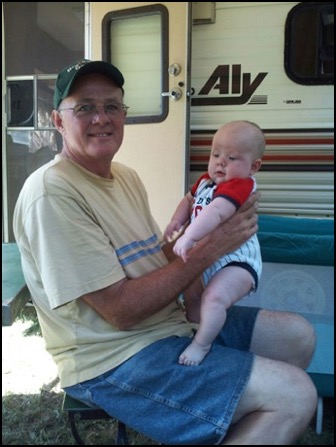
Here is Ryan watching while his Dad and his Grandpa are getting the last minute preps done before driving to the campground.

Grandpa Bob and Ryan after trailer is set up.

Lincoln Memorial
26/07/13 09:25 Filed in: History
It was very upsetting to hear that vandals splashed green paint on the Lincoln memorial statue and the granite around the it inside the larger Memorial building. This is such a wonderful, historical site in Washington DC. It is beyond criminal to do such damage to this spectacular part of U.S. history. Here is a link to a recent post on Lincoln and the Memorial.
Lincoln looking over his people at the Memorial
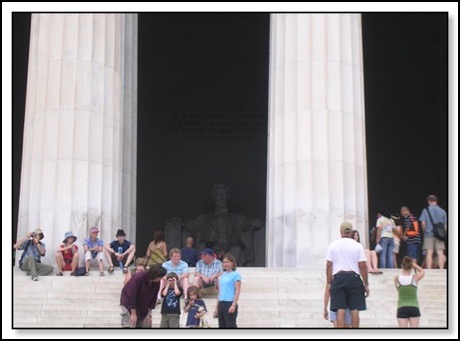
Scott at Lincoln’s statue (in memory of Abraham Lincoln) in July, 2007
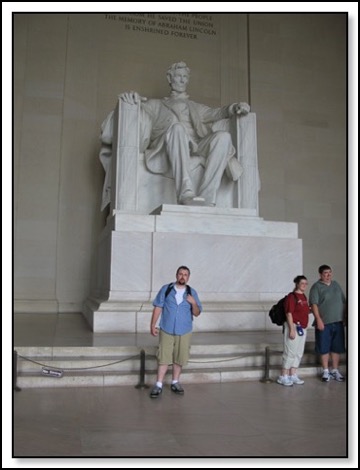
Lincoln looking over his people at the Memorial

Scott at Lincoln’s statue (in memory of Abraham Lincoln) in July, 2007

First Bull Run
25/07/13 09:49 Filed in: History
A good portion of the area where the Bull Run/Manassas battles took place are under freeways and shopping malls. They have managed to preserve some of the battlefield areas near Centreville in Virginia. Bob and I did visit this area when we traveled to Virginia Civil War sites in 2001. There were two different significant battles in this area, both were overall losses or routs for the Army of the Potomac. A good description of the First Bull Run battle is found here. I believe that the North liked to name battles after water source or geography close by and the South liked to name the battle after the town or community near where it took place.
Mary, Queen of Scots
24/07/13 09:12 Filed in: History
Now on to another individual who also lost her head, but for another reason. At least I don’t remember anyone counting her as a vampire. More a woman who could not keep her head or common sense around men. I have several books in my library about Mary and her history. Bob and I have visited Linlithgow Palace where she was born and also Falkland Palace where her father, James V, died and she later lived. We have visited Holyrood House in Edinburgh where she reigned and much of her scandalous history occurred. Read about Mary here.
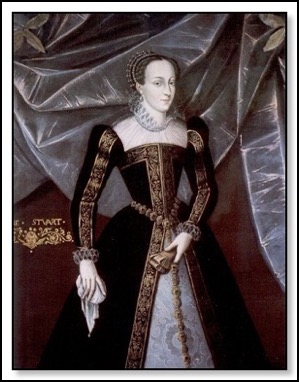
Mary, Queen of Scots
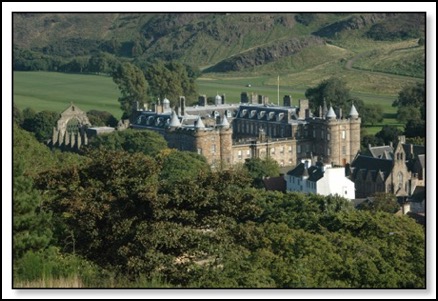
Holyrood House, Edinburgh, Scotland

Mary, Queen of Scots

Holyrood House, Edinburgh, Scotland
Vampires Do Exist
23/07/13 09:00 Filed in: History
Vampires do exist. At least in the minds of eastern European cultures from several centuries ago. In excavating burial sites, they have found some bodies with the skull separated from the body and placed between the legs. This is an old burial trick to keep the undead from rising to walk the earth again. Bodies in other locations have been found with metal stakes driven into the chest, another way to prevent the undead from leaving the grave. So, we just thought Bram Stoker had a very good, very scary story, heh? Bwaahaahaa!
Read about it here.

Read about it here.

The Eagle Has Landed at 44
22/07/13 20:11 Filed in: History
I should have caught this and made note 2 days ago. It was the 44th Anniversary of the Moon Landing, or “The Eagle Has Landed” on Saturday. On that day 44 years ago, I was in West Berlin, Germany on a People to People Ambassador Tour. We saw the news on a television in the visiting are of the hotel we were at. As this article comments, it was a mere 66 years from the flight of the Kitty Hawk to the moon landing and walk. How unbelievable is that?!
Enjoy the memories.
Enjoy the memories.
The Spy Who Loved
21/07/13 10:53 Filed in: History
Every now and then, a person comes across bits of lesser known history that fascinates and also is significant. I came across a book review describing spies from the time of World War II. One of the most useful and daring was a woman of Polish heritage who called herself Christine Glanville. From all descriptions, she was quite the woman who loved men and quite the derring-do spy.
Christine Granville was one of the bravest, toughest and strangest secret agents of World War II. Her feats of derring-do included acting as a courier in Nazi-occupied Europe, parachuting into France in support of the Allied invasion and rescuing three of her comrades from certain execution. She was said to be Winston Churchill’s favorite spy — a considerable accolade given how much Britain’s wartime prime minister liked spies. She may have been the model for Vesper Lynd, the female agent in Ian Fleming’s first James Bond novel, “Casino Royale.” She won medals for bravery from both Britain and France. Men found her irresistible, and she did very little to resist them. (from the NYTBR by Ben Macintyre)
Christine Glanville
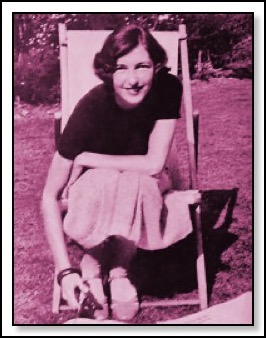
Christine Granville was one of the bravest, toughest and strangest secret agents of World War II. Her feats of derring-do included acting as a courier in Nazi-occupied Europe, parachuting into France in support of the Allied invasion and rescuing three of her comrades from certain execution. She was said to be Winston Churchill’s favorite spy — a considerable accolade given how much Britain’s wartime prime minister liked spies. She may have been the model for Vesper Lynd, the female agent in Ian Fleming’s first James Bond novel, “Casino Royale.” She won medals for bravery from both Britain and France. Men found her irresistible, and she did very little to resist them. (from the NYTBR by Ben Macintyre)
Christine Glanville

What Kind of Ending?
20/07/13 20:13 Filed in: Interests
I saw an interesting discussion yesterday about whether a person might prefer stories, shows, or movies that have happy endings or crave reaching that ultimate “downer” of a bad ending. I probably tend to lean toward the happy ending side. What I really like is a good, well-written, clever story. Something that makes you think or surprises you. The article under discussion did go further and covered 4 different examples of how different predictable patterns occur to destroy dramatic tension. Certainly, we all go to a thriller or drama and wonder who will be killed off or which character(s) will be left at the end. I would often speculate with our friend, Stephen, on who will be left standing. We often came close to getting it right. It can be a fun guessing game and you try to determine the pattern or profile they will want to have at the end. What sort of story ending do you like? Can you tell how a story will end or who will “not be there” for the next season? 
Detroit
19/07/13 08:51 Filed in: Community
Detroit will undergo Chapter 9 bankruptcy. The largest city in the USA to undergo bankruptcy. The Motor City was at one time one of the largest, most thriving cities in the country. It has lost more than half of its population from 1950. This would not be something I would normally focus on in my blog though this article in Powerline Blog about the scenario includes several photos from a book called The Ruin of Detroit. The photos are shocking on the state of a number of formally impressive buildings. These buildings deteriorated due to a lack of money and care, not war. The photos are just an example of a few of the 78,000 abandoned houses and commercial buildings in Detroit.
United Artists Theater

United Artists Theater

Books That Changed My Mind
18/07/13 08:35 Filed in: Interests
An interesting column the other day by Scott Johnson of Powerline Blog. He contemplated about books that had changed his thinking, primarily with the focus on political leanings. I have not read any of the books he listed. I would have to spend some time considering what I would list in a similar situation. I have written in this blog about books that have changed my beliefs or interests in the past. Some books that would come to the foreground that have had an effect are Melanie Phillip’s Londonistan. It has had a huge impact on my understanding of how our Western culture and civilization is being challenged. Another book is William Shirer’s tome, Rise and Fall of the Third Reich. It taught me about how the little twists and turns of our history lead to such huge upheavals to civilization along the way. One small change could have headed off a historical travesty or sent events off into another direction. The old counterfactual aspect of history.
I am sure there are many other books that I can add here. I will return to this piece to add more in the future.
I am sure there are many other books that I can add here. I will return to this piece to add more in the future.
Lightning Strikes
17/07/13 09:36 Filed in: Community
Earlier in the day, about 1:30 to 2 a.m. we had a fairly fast moving thunderstorm move over the house and mountains to the east of us. One lightning strike seemed to start on our right, as we sat on the balcony, off the bedroom, from over the trees to along the hillsides and tops of Green Peter. It was followed by a really loud, rolling clap of thunder. If we had not already been awake and watching the spectacle, it would have roused us out of bed quickly. This morning is cloud covered, so we shall see how soon the sun and heat come back. I expected some storms as possible. It was 83 degrees when we went into the Pioneer Villa in Brownsville at 6 pm and it was 68 degrees outside when we left 2.5 hours later. A real temperature drop.
World War I Battle Deaths
16/07/13 09:34 Filed in: History
Even almost 100 years later, the United States and Europe still feels the effect and remembers the crushing loss of so many promising lives during World War I. It seems as if every town and major city has a memorial to World War I in Great Britain, listing the names of the men who were lost from that community. This article lists the top battles of this war in the numbers of war deaths. To read through it is to give one a sense of why the memorials are still so important in those communities. We do not have a World War I memorial in Washington DC. Looking at the battles with the most loss of life, they occurred when the United States was part of the action. Maybe a stronger push should be made to create that memorial.
Softball night
15/07/13 21:21 Filed in: Community
David has been playing softball this summer for his church in their league. His usual position has been first base as it was when he played in Little League. He does seem to enjoy it. We went to watch tonight which was the first time for me to be a sideline supporter. It is though a great evening for the kids to get outdoors and use up a lot of energy playing along the sidelines too. Here is Nicolas and a friend checking out the play of the other Grandpa Bob.

Nathan at the ballgame. His shirt reads--“If Mom’s having a bad day…call 1-800-Grandma.”


Nathan at the ballgame. His shirt reads--“If Mom’s having a bad day…call 1-800-Grandma.”

Potluck Baby
Ryan got to attend his first Berlin Community Potluck at the Fire Station. Of course, his parents came to the potluck a couple of years ago on an early date together. Here is Ryan and his Mama.


Another Community Potluck
13/07/13 15:18 Filed in: Community
Another year, another community yard sale, and another community potluck. It is always good to get together with the neighbors and family.
Barbecuing at the Berlin Fire Station and all new community photos

Gathering with family at the community potluck today
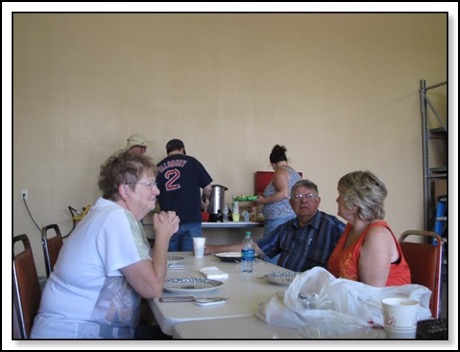
Barbecuing at the Berlin Fire Station and all new community photos

Gathering with family at the community potluck today

Hamilton
12/07/13 15:29 Filed in: History
One book that Bob enjoyed to read was Ron Chernow’s biography on Alexander Hamilton. A brilliant, yet followed by scandal, individual. He contributed mightily to our country’s founding government and financial status. Here is an interesting short biographical sketch about Alexander Hamilton’s history. Another story about the pistols used in the Hamilton-Burr duel that may have lead to Hamilton’s untimely demise. The pistol may have been a “trick pistol” with a hair trigger.
King Leopold's Ghost
11/07/13 19:26 Filed in: Interests
Another of the myriad of books I own is one about King Leopold of Belgium, King Leopold’s Ghost. In the 1800’s, he decided he needed to have more territory as a colony and income for his kingdom of Belgium. He moved soldiers into the country of the Congo in Africa and over time, made the population slaves to his industry. Stanley of history fame was actually his agent in the initial colonization of the Congo His industry was the takeover of the rubber industry. Many of the population died during this occupancy and he was able to hide it from the rest of the world for awhile. Eventually, word leaked out. More details about the dark chapter in history are found here.
Overhead
10/07/13 19:23 Filed in: Community
At one point during the fireworks last Thursday, I was able to catch a photo of fireworks going off directly overhead. They were so close some of the particulates from the fireworks would land on my head. Here is one photo of a direct shot overhead.


Military Blunders
09/07/13 19:18 Filed in: History
Pilot Error
08/07/13 10:02 Filed in: Interests
There has been a lot of focus the past few days on a Boeing 777 plane that crashed on landing at San Francisco International Airport. It is an airport I have flown into a number of times. The weather was good at the time and from all the news coverage and a look at the site, I said early on this had the hallmarks of pilot error. All the data and information is leaning that way currently. This morning has a posting of a video that followed the whole landing and it is a miracle the plane did not cartwheel at the end as initially reported. I can see why they felt it had landed on its top based on eye witness reports after viewing this video.
Garden Parterre
07/07/13 12:13 Filed in: Interests
Our garden parterre is looking a bit more established or older. The boxwoods still have some issues of parts of the plants dying for some reason and then coming back. Here is a view of it this summer.


Gettysburg Aftermath
06/07/13 08:58 Filed in: History
What followed Gettysburg? Armies retreating, burying the dead, tending to the injured. Lincoln attending a ceremony to honor the sacrifice of the dead soldiers and to deliver the Gettysburg Address. It was probably the most pithy and greatest speech ever given. We still consecrate those dead and remember 150 years later what happened on the ridges, dens, hilltops, and fields of Gettysburg.
Commemorative memorial to Lincoln at Gettysburg cemetery
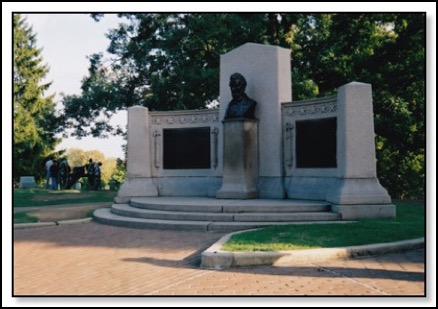
Gettysburg Address engraved at the Lincoln Memorial
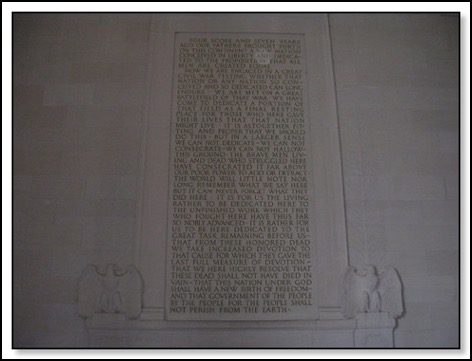
Battle of Gettysburg, Aftermath
On July 4, Lee started a 27-mile-long train of hospital wagons down the road to Virginia. His army halted at the flooded Potomac River and entrenched for another battle, but Meade’s army, too, was battered and exhausted and had consumed much of its ammunition. The Army of the Potomac did not pursue, for which Meade would be soundly criticized. He remained in command of that army for the rest of the war, even after Ulysses S. Grant was promoted to lieutenant general, placed over all Northern armies and attached himself to the Army of the Potomac. Lee offered his resignation to Confederate president Jefferson Davis, but it was refused and he, too, remained in command for the rest of the war.
Facts about the Battle of Gettysburg
Ammunition at Gettysburg: An estimated 569 tons of ammunition was fired during the three days of fighting.
Abraham Lincoln’s Gettysburg Address was delivered November 19, 1863, at the dedication of the “Soldiers’ National Cemetery” at Gettysburg. The speech was extremely short by the standards of the day and received scant notice at the time, but its concise, powerful wording has made it one of the best-known public addresses in all of history. Contrary to popular myth, Lincoln did not scribble the speech on the back of an envelope on his way to Gettysburg but wrote several drafts. The last bodies would not be retrieved from battlefield graves and reinterred in the cemetery until months after the dedication ceremonies.
John Buford, whose cavalry fired the first shots of the battle, died December 16, 1863. His death is thought to have resulted from typhoid fever and a body weakened by exhaustion. He received a deathbed promotion to major general, post-dated to July 1, 1863.
Civilians at Gettysburg were left to deal with the thousands of wounded. Homes and public buildings became hospitals, and diseases born of infection and unsanitary conditions made living in the town risky. Volunteers came from the North and the South, however, to aid in caring for the wounded, burying the dead, and piling and burning carcasses of horses and mules killed in the fighting.
During the battle, a random bullet went through the door of a house, striking and killing 20-year-old Mary Virginia (Jenny) Wade. She was the only civilian killed during the battle.
Commemorative memorial to Lincoln at Gettysburg cemetery

Gettysburg Address engraved at the Lincoln Memorial

Battle of Gettysburg, Aftermath
On July 4, Lee started a 27-mile-long train of hospital wagons down the road to Virginia. His army halted at the flooded Potomac River and entrenched for another battle, but Meade’s army, too, was battered and exhausted and had consumed much of its ammunition. The Army of the Potomac did not pursue, for which Meade would be soundly criticized. He remained in command of that army for the rest of the war, even after Ulysses S. Grant was promoted to lieutenant general, placed over all Northern armies and attached himself to the Army of the Potomac. Lee offered his resignation to Confederate president Jefferson Davis, but it was refused and he, too, remained in command for the rest of the war.
Facts about the Battle of Gettysburg
Ammunition at Gettysburg: An estimated 569 tons of ammunition was fired during the three days of fighting.
Abraham Lincoln’s Gettysburg Address was delivered November 19, 1863, at the dedication of the “Soldiers’ National Cemetery” at Gettysburg. The speech was extremely short by the standards of the day and received scant notice at the time, but its concise, powerful wording has made it one of the best-known public addresses in all of history. Contrary to popular myth, Lincoln did not scribble the speech on the back of an envelope on his way to Gettysburg but wrote several drafts. The last bodies would not be retrieved from battlefield graves and reinterred in the cemetery until months after the dedication ceremonies.
John Buford, whose cavalry fired the first shots of the battle, died December 16, 1863. His death is thought to have resulted from typhoid fever and a body weakened by exhaustion. He received a deathbed promotion to major general, post-dated to July 1, 1863.
Civilians at Gettysburg were left to deal with the thousands of wounded. Homes and public buildings became hospitals, and diseases born of infection and unsanitary conditions made living in the town risky. Volunteers came from the North and the South, however, to aid in caring for the wounded, burying the dead, and piling and burning carcasses of horses and mules killed in the fighting.
During the battle, a random bullet went through the door of a house, striking and killing 20-year-old Mary Virginia (Jenny) Wade. She was the only civilian killed during the battle.
Independence the American Way
The 4th of July, Independence Day is supposed to be a day of family, leisure, barbecues, and fireworks. We seemed to take it all in though Bob was out mowing down the remaining grass in our hay field during the day. Later in the afternoon, we followed the usual prescription and had 4th of July celebration at the Lewis household.
Ryan’s first 4th of July and he is all decked out.

Nicolas and Nathan getting down to the business of fun.

And then the fireworks!! (too busy eating to add in a photo of food)

Ryan’s first 4th of July and he is all decked out.

Nicolas and Nathan getting down to the business of fun.

And then the fireworks!! (too busy eating to add in a photo of food)

Independence Day and Vicksburg
04/07/13 09:33 Filed in: History
We have not made it to Vicksburg to visit Civil War sites. Vicksburg did fall on this day 150 years ago to General Grant. Gettysburg had led to a defeat of the Confederate Army and its slow withdrawal from Pennsylvania back to Virginia.
One reason we can celebrate our Independence Day together as a country is due to the character and foresight of Abraham Lincoln. In some of the early Lincoln-Douglas debates, there is a speech from July 10,1858 where Lincoln replied to Douglas. As one column states, its eloquence concludes with what this Independence Day means to many Americans.
“Now, it happens that we meet together once every year, sometime about the 4th of July, for some reason or other. These 4th of July gatherings I suppose have their uses. If you will indulge me, I will state what I suppose to be some of them.
We are now a mighty nation, we are thirty—or about thirty millions of people, and we own and inhabit about one-fifteenth part of the dry land of the whole earth. We run our memory back over the pages of history for about eighty-two years and we discover that we were then a very small people in point of numbers, vastly inferior to what we are now, with a vastly less extent of country,—with vastly less of everything we deem desirable among men,—we look upon the change as exceedingly advantageous to us and to our posterity, and we fix upon something that happened away back, as in some way or other being connected with this rise of prosperity. We find a race of men living in that day whom we claim as our fathers and grandfathers; they were iron men, they fought for the principle that they were contending for; and we understood that by what they then did it has followed that the degree of prosperity that we now enjoy has come to us. We hold this annual celebration to remind ourselves of all the good done in this process of time of how it was done and who did it, and how we are historically connected with it; and we go from these meetings in better humor with ourselves—we feel more attached the one to the other, and more firmly bound to the country we inhabit. In every way we are better men in the age, and race, and country in which we live for these celebrations. But after we have done all this we have not yet reached the whole. There is something else connected with it. We have besides these men—descended by blood from our ancestors—among us perhaps half our people who are not descendants at all of these men, they are men who have come from Europe—German, Irish, French and Scandinavian—men that have come from Europe themselves, or whose ancestors have come hither and settled here, finding themselves our equals in all things. If they look back through this history to trace their connection with those days by blood, they find they have none, they cannot carry themselves back into that glorious epoch and make themselves feel that they are part of us, but when they look through that old Declaration of Independence they find that those old men say that “We hold these truths to be self-evident, that all men are created equal,” and then they feel that that moral sentiment taught in that day evidences their relation to those men, that it is the father of all moral principle in them, and that they have a right to claim it as though they were blood of the blood, and flesh of the flesh of the men who wrote that Declaration [loud and long continued applause], and so they are. That is the electric cord in that Declaration that links the hearts of patriotic and liberty-loving men together, that will link those patriotic hearts as long as the love of freedom exists in the minds of men throughout the world. [Applause.]
Now, sirs, for the purpose of squaring things with this idea of “don’t care if slavery is voted up or voted down” [Douglas's "popular sovereignty" position on the extension of slavery to the territories], for sustaining the Dred Scott decision [A voice---"Hit him again"], for holding that the Declaration of Independence did not mean anything at all, we have Judge Douglas giving his exposition of what the Declaration of Independence means, and we have him saying that the people of America are equal to the people of England. According to his construction, you Germans are not connected with it. Now I ask you in all soberness, if all these things, if indulged in, if ratified, if confirmed and endorsed, if taught to our children, and repeated to them, do not tend to rub out the sentiment of liberty in the country, and to transform this Government into a government of some other form. Those arguments that are made, that the inferior race are to be treated with as much allowance as they are capable of enjoying; that as much is to be done for them as their condition will allow. What are these arguments? They are the arguments that kings have made for enslaving the people in all ages of the world. You will find that all the arguments in favor of king-craft were of this class; they always bestrode the necks of the people, not that they wanted to do it, but because the people were better off for being ridden. That is their argument, and this argument of the Judge is the same old serpent that says you work and I eat, you toil and I will enjoy the fruits of it. Turn in whatever way you will—whether it come from the mouth of a King, an excuse for enslaving the people of his country, or from the mouth of men of one race as a reason for enslaving the men of another race, it is all the same old serpent, and I hold if that course of argumentation that is made for the purpose of convincing the public mind that we should not care about this, should be granted, it does not stop with the negro. I should like to know if taking this old Declaration of Independence, which declares that all men are equal upon principle and making exceptions to it where will it stop. If one man says it does not mean a negro, why not another say it does not mean some other man? If that declaration is not the truth, let us get the Statute book, in which we find it and tear it out! Who is so bold as to do it! [Voices---"me" "no one," &c.] If it is not true let us tear it out! [cries of "no, no,"] let us stick to it then [cheers], let us stand firmly by it then. [Applause.]”

One reason we can celebrate our Independence Day together as a country is due to the character and foresight of Abraham Lincoln. In some of the early Lincoln-Douglas debates, there is a speech from July 10,1858 where Lincoln replied to Douglas. As one column states, its eloquence concludes with what this Independence Day means to many Americans.
“Now, it happens that we meet together once every year, sometime about the 4th of July, for some reason or other. These 4th of July gatherings I suppose have their uses. If you will indulge me, I will state what I suppose to be some of them.
We are now a mighty nation, we are thirty—or about thirty millions of people, and we own and inhabit about one-fifteenth part of the dry land of the whole earth. We run our memory back over the pages of history for about eighty-two years and we discover that we were then a very small people in point of numbers, vastly inferior to what we are now, with a vastly less extent of country,—with vastly less of everything we deem desirable among men,—we look upon the change as exceedingly advantageous to us and to our posterity, and we fix upon something that happened away back, as in some way or other being connected with this rise of prosperity. We find a race of men living in that day whom we claim as our fathers and grandfathers; they were iron men, they fought for the principle that they were contending for; and we understood that by what they then did it has followed that the degree of prosperity that we now enjoy has come to us. We hold this annual celebration to remind ourselves of all the good done in this process of time of how it was done and who did it, and how we are historically connected with it; and we go from these meetings in better humor with ourselves—we feel more attached the one to the other, and more firmly bound to the country we inhabit. In every way we are better men in the age, and race, and country in which we live for these celebrations. But after we have done all this we have not yet reached the whole. There is something else connected with it. We have besides these men—descended by blood from our ancestors—among us perhaps half our people who are not descendants at all of these men, they are men who have come from Europe—German, Irish, French and Scandinavian—men that have come from Europe themselves, or whose ancestors have come hither and settled here, finding themselves our equals in all things. If they look back through this history to trace their connection with those days by blood, they find they have none, they cannot carry themselves back into that glorious epoch and make themselves feel that they are part of us, but when they look through that old Declaration of Independence they find that those old men say that “We hold these truths to be self-evident, that all men are created equal,” and then they feel that that moral sentiment taught in that day evidences their relation to those men, that it is the father of all moral principle in them, and that they have a right to claim it as though they were blood of the blood, and flesh of the flesh of the men who wrote that Declaration [loud and long continued applause], and so they are. That is the electric cord in that Declaration that links the hearts of patriotic and liberty-loving men together, that will link those patriotic hearts as long as the love of freedom exists in the minds of men throughout the world. [Applause.]
Now, sirs, for the purpose of squaring things with this idea of “don’t care if slavery is voted up or voted down” [Douglas's "popular sovereignty" position on the extension of slavery to the territories], for sustaining the Dred Scott decision [A voice---"Hit him again"], for holding that the Declaration of Independence did not mean anything at all, we have Judge Douglas giving his exposition of what the Declaration of Independence means, and we have him saying that the people of America are equal to the people of England. According to his construction, you Germans are not connected with it. Now I ask you in all soberness, if all these things, if indulged in, if ratified, if confirmed and endorsed, if taught to our children, and repeated to them, do not tend to rub out the sentiment of liberty in the country, and to transform this Government into a government of some other form. Those arguments that are made, that the inferior race are to be treated with as much allowance as they are capable of enjoying; that as much is to be done for them as their condition will allow. What are these arguments? They are the arguments that kings have made for enslaving the people in all ages of the world. You will find that all the arguments in favor of king-craft were of this class; they always bestrode the necks of the people, not that they wanted to do it, but because the people were better off for being ridden. That is their argument, and this argument of the Judge is the same old serpent that says you work and I eat, you toil and I will enjoy the fruits of it. Turn in whatever way you will—whether it come from the mouth of a King, an excuse for enslaving the people of his country, or from the mouth of men of one race as a reason for enslaving the men of another race, it is all the same old serpent, and I hold if that course of argumentation that is made for the purpose of convincing the public mind that we should not care about this, should be granted, it does not stop with the negro. I should like to know if taking this old Declaration of Independence, which declares that all men are equal upon principle and making exceptions to it where will it stop. If one man says it does not mean a negro, why not another say it does not mean some other man? If that declaration is not the truth, let us get the Statute book, in which we find it and tear it out! Who is so bold as to do it! [Voices---"me" "no one," &c.] If it is not true let us tear it out! [cries of "no, no,"] let us stick to it then [cheers], let us stand firmly by it then. [Applause.]”

Gettysburg at 150, Third Day
03/07/13 16:03 Filed in: History
The last day of the battle………….Pickett’s Charge. One last push that was never enough. Lee gambled and his soldiers paid this day 150 years ago. More than one mile across the fields from Seminary Ridge, the Emmitsburg Road to the stone wall and The Angle. They almost made it, yet the Union held.
Looking toward Seminary Ridge from the stone wall, Pickett’s Charge
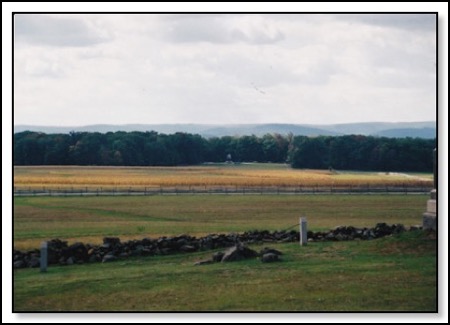
Clash of colours and cultures, the high watermark, at The Angle
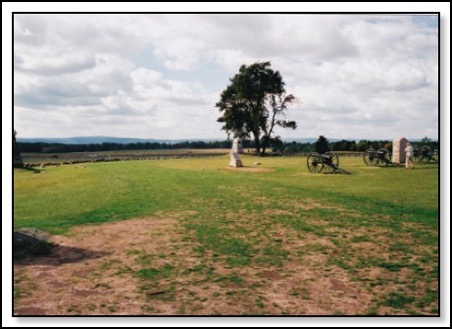
Gettysburg, Day 3
Throughout the war, Robert E. Lee had always sought a way to “get at those people over there.” His aggressiveness had served the Confederate cause well on many battlefields, but on July 3, 1863, it led to disaster.
Despite the passionate arguments of Longstreet, Lee instructed his “Old War Horse” to strike the Union center on Cemetery Ridge, using the divisions of Brig. Gen. James Johnston Pettigrew, Maj. Gen. Isaac Ridgeway Trimble, and the recently arrived division of Maj. Gen. George Pickett. In all, approximately 15,000 men were to advance three-quarters of a mile across open ground, climb fences along the roads, and charge up the gradual but steep slope of Cemetery Ridge to assail a force of about 6,500, but the Federals had reinforcements close by.
At 1:00 in the afternoon, a prolonged artillery barrage by the Confederates, utilizing an unprecedented number of guns spread two miles wide, preceded the assault, intended to silence the Union’s cannons and weaken the infantry. Most of its shells went high, plunging to earth behind the Federals’ line, though some found their mark. One nearly struck Meade, standing outside his headquarters.
For a time, Federal guns replied, until the order came down to conserve ammunition for the attack that was obviously coming. When the Union cannons fell silent, Lee’s artillery chief, Col. Edward Porter Alexander, sent word for Longstreet to bring up his men.
Pettigrew’s division of four brigades formed the left of the attack line, with two of Trimble’s brigades behind them and to their right for support. Pickett’s men stepped out on the right.
The advance was disordered by terrain and by flanking fire on Pettigrew’s left as it neared the Union line. Pickett’s advance drifted left, exposing his right to enemy fire. Through shot, shell, canister and rifle fire, the long Confederate line surged forward. Near the Union center, it broke through temporarily until reinforcements drove it back. As the survivors straggled back to Confederate lines at Seminary Ridge, many of them passed Robert E. Lee, who told them, “It is my fault.”
The day also saw cavalry action, as the horsemen of brigadier generals George Custer and David Gregg stymied Stuart’s attempt to get into the Union rear..
- See more at:
Looking toward Seminary Ridge from the stone wall, Pickett’s Charge

Clash of colours and cultures, the high watermark, at The Angle

Gettysburg, Day 3
Throughout the war, Robert E. Lee had always sought a way to “get at those people over there.” His aggressiveness had served the Confederate cause well on many battlefields, but on July 3, 1863, it led to disaster.
Despite the passionate arguments of Longstreet, Lee instructed his “Old War Horse” to strike the Union center on Cemetery Ridge, using the divisions of Brig. Gen. James Johnston Pettigrew, Maj. Gen. Isaac Ridgeway Trimble, and the recently arrived division of Maj. Gen. George Pickett. In all, approximately 15,000 men were to advance three-quarters of a mile across open ground, climb fences along the roads, and charge up the gradual but steep slope of Cemetery Ridge to assail a force of about 6,500, but the Federals had reinforcements close by.
At 1:00 in the afternoon, a prolonged artillery barrage by the Confederates, utilizing an unprecedented number of guns spread two miles wide, preceded the assault, intended to silence the Union’s cannons and weaken the infantry. Most of its shells went high, plunging to earth behind the Federals’ line, though some found their mark. One nearly struck Meade, standing outside his headquarters.
For a time, Federal guns replied, until the order came down to conserve ammunition for the attack that was obviously coming. When the Union cannons fell silent, Lee’s artillery chief, Col. Edward Porter Alexander, sent word for Longstreet to bring up his men.
Pettigrew’s division of four brigades formed the left of the attack line, with two of Trimble’s brigades behind them and to their right for support. Pickett’s men stepped out on the right.
The advance was disordered by terrain and by flanking fire on Pettigrew’s left as it neared the Union line. Pickett’s advance drifted left, exposing his right to enemy fire. Through shot, shell, canister and rifle fire, the long Confederate line surged forward. Near the Union center, it broke through temporarily until reinforcements drove it back. As the survivors straggled back to Confederate lines at Seminary Ridge, many of them passed Robert E. Lee, who told them, “It is my fault.”
The day also saw cavalry action, as the horsemen of brigadier generals George Custer and David Gregg stymied Stuart’s attempt to get into the Union rear..
- See more at:
Gettysburg at 150, Second Day
02/07/13 09:43 Filed in: History
The second day was the bloodiest day of the three at Gettysburg. The Union soldiers had retreated and dug in on Cemetery Ridge, Little Round Top, and Culp’s Hill. Battles such as at the Peach Orchard, the Wheat field, and Devil’s Den occurred. Following are photos from some of these areas.
Devil’s Den
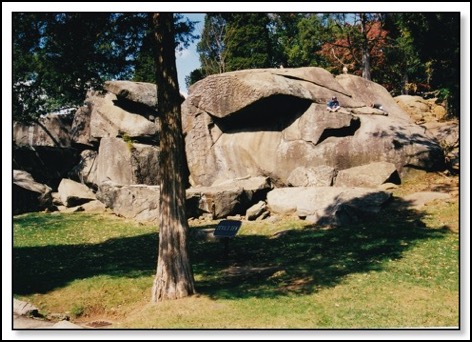
Soldiers for re-enactments at Gettysburg near the Peach Orchard
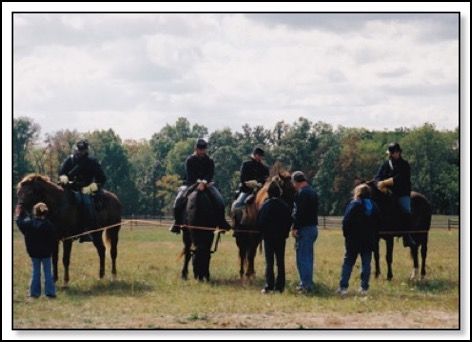
Gettysburg, Day 2
James Longstreet’s corps had arrived, and his 20,000 men were sent to outflank the Union left, which was anchored to the south by two eminences known as Little Round Top and Big Round Top. But the Federals had failed to place troops upon those hills, as Lee learned from an early morning reconnaissance report. Ewell was to make a demonstration against Culp’s and Cemetery hills on the Union right and to use his own discretion about launching a full-scale attack.
Longstreet’s men, moving toward their objective, had to reverse, countermarch and take a different route after Brigadier General Lafayette McLaws discovered the planned route would put them in full view of the Federals, negating any advantage of surprise. This cost valuable time but, as events turned out, a Union general was about to present them an unexpected opportunity.
Read More in America’s Civil War Magazine
Subscribe online and save nearly 40%!!!
All but one of Meade’s seven corps were now on the field, deployed in a fish-hook shape with its center along Cemetery Ridge; the defensive positions on Culp’s and Cemetery hills formed the hook at one end. The left was held by Major General Daniel Sickles, who owed his military rank to his political importance in the essential state of New York.
Dissatisfied with his position at the lower end of Cemetery Ridge, he took it upon himself to advance his III Corps nearly a half-mile west toward the Emmitsburg Pike and open high ground in a wheat field near a peach orchard. The move dangerously stretched his 10,000-man corps. Longstreet’s men attacked Sickle’s new position, and the fighting at rocky Devil’s Den, the wheat field and the peach orchard was among the fiercest and bloodiest of the three days.
Meade, faced with Sickles’ blunder, sent V Corps and part of the XI to reinforce him. New York’s Irish Brigade received Last Rites from a Catholic priest before charging into the fray; 198 of them would not return from the desperate fighting in the hot, sultry afternoon.
Above the blood-soaked fields, a similar drama was playing out on Little Round Top. Around 4:30 p.m., men of Alabama, Texas and Arkansas, from John Bell Hood’s Division in Longstreet’s Corps, began ascending the steep hill from the west. Had they arrived two hours earlier, they would have captured the heights unopposed, but by the time they arrived Meade’s chief of engineers, Brig. Gen. Gouveneur K. Warren, had discovered the potentially disastrous situation and sent messages to Sickles, who could not send even a single regiment by that time.
One message found its way to Colonel Strong Vincent, commanding 3rd Brigade, 1st Division, of the Federals’ V Corps. He double-timed his men and deployed them among the rocks and trees of Little Round Top’s western and southern slopes. The fate of the Union Army, at that moment, rested on the shoulders of 1,350 men of the 83rd Pennsylvania, 44th New York, 16th Michigan and 20th Maine regiments. Vincent’s orders were to “hold this ground at all costs!”
Nearly 650 Rebels of the 15th Alabama stormed into the saddle between the Round Tops around 6:00 p.m., and into the muzzles of Colonel Joshua Chamberlain’s 20th Maine. After an hour of intense fighting, Chamberlain’s 300-plus men had nearly exhausted their 15,000 rounds of ammunition. He ordered a countercharge. The surprised Alabamians fell back and attempted to make a stand, but Company B of the 20th Maine, which had been detached to cover the regiment’s flank, and fourteen of Hiram Berdan’s Sharpshooters rose from behind a stone wall and charged the Confederates’ flank. Convinced they were outnumbered, the men of the 15th and 47th Alabama retreated onto Big Round Top.
On the western slope, Colonel Vincent’s other regiments also stood firm until part of the 16th Michigan was pushed back. Gouvenor Warren, receiving a plea for reinforcements, ordered the 140th New York Zouaves to charge, and they broke the Rebels’ line long enough for more reinforcements to arrive.
By the time the sun went down on the second day at Gettysburg, the Union left still held, but III Corps would no longer be a significant factor in the battle, and V Corps had been badly mauled. Meanwhile, a desperate contest was taking place on the slope of Cemetery Hill.
Ewell’s troops had advanced from around the town of Gettysburg to assault Culp’s and Cemetery hills. For an hour they struggled across rough ground while Union batteries threw shot and shell among them, but when they got far enough up the slopes, the Federals could not depress their barrels enough to fire into them, and the Rebels routed infantry of the XI Corps. Union regiments pulled from one area of Cemetery Hill to plug a gap created by the retreat created their own gap, and Confederate infantry poured through.
Down on Cemetery Ridge, Winfield Hancock sent the 14th Indiana and 7th West Virginia regiments to reinforce Cemetery Hill. Arriving after dark, they formed up and charged into the Rebels who were fighting with artillerymen around the Union guns. The Confederates fell back. In one of the ironic events of the war, the 7th West Virginia, which had been the 7th Virginia (Union) until June 20 when West Virginia was admitted as a state, fought hand to hand with the 7th Virginia of the Confederacy, capturing a nephew of their own regimental commander.
The long day of bloodshed finally ended. Meade called together his commanders for a council of war. He’d already sent a message to the War Department stating that he intended to stay and fight; he may have called the council in order to make sure no one would do the next day what Sickles had done. Meade’s army had been attacked on the left and the right; that fact, combined with other intelligence he’d received, led him to believe his center would be the target the next day.
Read more about General Lee’s plan for Gettysburg Day 2
- See more at:
Devil’s Den

Soldiers for re-enactments at Gettysburg near the Peach Orchard

Gettysburg, Day 2
James Longstreet’s corps had arrived, and his 20,000 men were sent to outflank the Union left, which was anchored to the south by two eminences known as Little Round Top and Big Round Top. But the Federals had failed to place troops upon those hills, as Lee learned from an early morning reconnaissance report. Ewell was to make a demonstration against Culp’s and Cemetery hills on the Union right and to use his own discretion about launching a full-scale attack.
Longstreet’s men, moving toward their objective, had to reverse, countermarch and take a different route after Brigadier General Lafayette McLaws discovered the planned route would put them in full view of the Federals, negating any advantage of surprise. This cost valuable time but, as events turned out, a Union general was about to present them an unexpected opportunity.
Read More in America’s Civil War Magazine
Subscribe online and save nearly 40%!!!
All but one of Meade’s seven corps were now on the field, deployed in a fish-hook shape with its center along Cemetery Ridge; the defensive positions on Culp’s and Cemetery hills formed the hook at one end. The left was held by Major General Daniel Sickles, who owed his military rank to his political importance in the essential state of New York.
Dissatisfied with his position at the lower end of Cemetery Ridge, he took it upon himself to advance his III Corps nearly a half-mile west toward the Emmitsburg Pike and open high ground in a wheat field near a peach orchard. The move dangerously stretched his 10,000-man corps. Longstreet’s men attacked Sickle’s new position, and the fighting at rocky Devil’s Den, the wheat field and the peach orchard was among the fiercest and bloodiest of the three days.
Meade, faced with Sickles’ blunder, sent V Corps and part of the XI to reinforce him. New York’s Irish Brigade received Last Rites from a Catholic priest before charging into the fray; 198 of them would not return from the desperate fighting in the hot, sultry afternoon.
Above the blood-soaked fields, a similar drama was playing out on Little Round Top. Around 4:30 p.m., men of Alabama, Texas and Arkansas, from John Bell Hood’s Division in Longstreet’s Corps, began ascending the steep hill from the west. Had they arrived two hours earlier, they would have captured the heights unopposed, but by the time they arrived Meade’s chief of engineers, Brig. Gen. Gouveneur K. Warren, had discovered the potentially disastrous situation and sent messages to Sickles, who could not send even a single regiment by that time.
One message found its way to Colonel Strong Vincent, commanding 3rd Brigade, 1st Division, of the Federals’ V Corps. He double-timed his men and deployed them among the rocks and trees of Little Round Top’s western and southern slopes. The fate of the Union Army, at that moment, rested on the shoulders of 1,350 men of the 83rd Pennsylvania, 44th New York, 16th Michigan and 20th Maine regiments. Vincent’s orders were to “hold this ground at all costs!”
Nearly 650 Rebels of the 15th Alabama stormed into the saddle between the Round Tops around 6:00 p.m., and into the muzzles of Colonel Joshua Chamberlain’s 20th Maine. After an hour of intense fighting, Chamberlain’s 300-plus men had nearly exhausted their 15,000 rounds of ammunition. He ordered a countercharge. The surprised Alabamians fell back and attempted to make a stand, but Company B of the 20th Maine, which had been detached to cover the regiment’s flank, and fourteen of Hiram Berdan’s Sharpshooters rose from behind a stone wall and charged the Confederates’ flank. Convinced they were outnumbered, the men of the 15th and 47th Alabama retreated onto Big Round Top.
On the western slope, Colonel Vincent’s other regiments also stood firm until part of the 16th Michigan was pushed back. Gouvenor Warren, receiving a plea for reinforcements, ordered the 140th New York Zouaves to charge, and they broke the Rebels’ line long enough for more reinforcements to arrive.
By the time the sun went down on the second day at Gettysburg, the Union left still held, but III Corps would no longer be a significant factor in the battle, and V Corps had been badly mauled. Meanwhile, a desperate contest was taking place on the slope of Cemetery Hill.
Ewell’s troops had advanced from around the town of Gettysburg to assault Culp’s and Cemetery hills. For an hour they struggled across rough ground while Union batteries threw shot and shell among them, but when they got far enough up the slopes, the Federals could not depress their barrels enough to fire into them, and the Rebels routed infantry of the XI Corps. Union regiments pulled from one area of Cemetery Hill to plug a gap created by the retreat created their own gap, and Confederate infantry poured through.
Down on Cemetery Ridge, Winfield Hancock sent the 14th Indiana and 7th West Virginia regiments to reinforce Cemetery Hill. Arriving after dark, they formed up and charged into the Rebels who were fighting with artillerymen around the Union guns. The Confederates fell back. In one of the ironic events of the war, the 7th West Virginia, which had been the 7th Virginia (Union) until June 20 when West Virginia was admitted as a state, fought hand to hand with the 7th Virginia of the Confederacy, capturing a nephew of their own regimental commander.
The long day of bloodshed finally ended. Meade called together his commanders for a council of war. He’d already sent a message to the War Department stating that he intended to stay and fight; he may have called the council in order to make sure no one would do the next day what Sickles had done. Meade’s army had been attacked on the left and the right; that fact, combined with other intelligence he’d received, led him to believe his center would be the target the next day.
Read more about General Lee’s plan for Gettysburg Day 2
- See more at:
Gettysburg at 150, First Day
01/07/13 21:23 Filed in: History
In 2001, shortly after 9-11 we traveled back to Philadelphia for a meeting. Afterwards, we spent time in parts of Pennsylvania, Washington DC, and Virginia. The major part of Pennsylvania was a visit to the Gettysburg Battlefield. What a special memory! We did a driving tour with audio (we still have the audio to listen to) around the various sites. It was a great overview though one never does get in everything. Today is the 150th anniversary of the first day of battle at Gettysburg.
Here is a modern day photo of the driving lane and monuments along the ridge where the first sightings and skirmishes occurred between the Boys in Blue and the Johnny Rebs. Did General Ewell lose the battle on this day by his actions? This area of McPherson’s Ridge was near to where we stayed in a B&B.
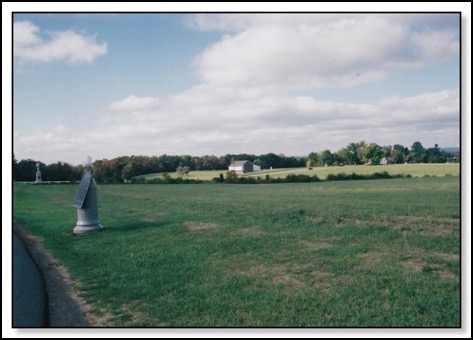
The town of Gettysburg, PA as you come up to it. It has much the same flavor as it must have in the days before the battle.


Gettysburg, Day 1
On the morning of July 1, Major General Henry Heth, of A.P. Hill’s Third Corps, sent his 7,500-man division down the Chambersburg Pike toward Gettysburg. Encountering resistance, they initially assumed it was more of the hastily assembled Pennsylvania Emergency Militia that they’d been skirmishing with during the campaign.
In reality, Colonel John Buford had deployed part of two brigades of Union cavalry as skirmishers in the brush along Willoughby’s Run three miles west of town. Just two weeks previously, they’d been issued breech-loading carbines, and they used the guns’ fast-loading capability to create the impression of a much larger force, slowing the advance of Hill’s brigades for a time before falling back.
The Confederates followed them across the stream, only to meet a line of Union infantry on McPherson’s Ridge. The Army of the Potomac was arriving piecemeal, and among the first to arrive was a brigade of Western regiments that had earned the nickname “Iron Brigade of the West.” Confederates recognized these “fellows in the black hats” and realized they were in for a rougher day than expected.
Union major general John Reynolds, commander of the left wing of the Army of the Potomac (I, III and XI corps), arrived and took charge of the defense. His men fought tenaciously, and Reynolds was shot dead during the fighting.
From his headquarters at Taneytown, Meade dispatched Major General Winfield Scott Hancock to take command at Gettysburg—although Major General O. O. Howard was already on the field—and assess whether or not the battle should be fought there. Hancock, seeing the strong defensive position offered by the hills near Gettysburg, chose to stand, and Meade ordered the other corps to the little crossroads town.
By afternoon, Confederate reinforcements had also arrived, and the general engagement Lee hadn’t wanted at this stage of the campaign was a fait accompli.
The Union’s XI Corps was driven back through the town of Gettysburg, losing 4,000 men, and by evening was entrenching on Culp’s and Cemetery hills south of town.
Lee expressed a desire for General Ewell to assault the hills without waiting for further reinforcement, but he failed to make it an express order. Ewell did not press his tired men forward, giving Meade time to reinforce the troops on the hills.
- See more at:
Here is a modern day photo of the driving lane and monuments along the ridge where the first sightings and skirmishes occurred between the Boys in Blue and the Johnny Rebs. Did General Ewell lose the battle on this day by his actions? This area of McPherson’s Ridge was near to where we stayed in a B&B.

The town of Gettysburg, PA as you come up to it. It has much the same flavor as it must have in the days before the battle.


Gettysburg, Day 1
On the morning of July 1, Major General Henry Heth, of A.P. Hill’s Third Corps, sent his 7,500-man division down the Chambersburg Pike toward Gettysburg. Encountering resistance, they initially assumed it was more of the hastily assembled Pennsylvania Emergency Militia that they’d been skirmishing with during the campaign.
In reality, Colonel John Buford had deployed part of two brigades of Union cavalry as skirmishers in the brush along Willoughby’s Run three miles west of town. Just two weeks previously, they’d been issued breech-loading carbines, and they used the guns’ fast-loading capability to create the impression of a much larger force, slowing the advance of Hill’s brigades for a time before falling back.
The Confederates followed them across the stream, only to meet a line of Union infantry on McPherson’s Ridge. The Army of the Potomac was arriving piecemeal, and among the first to arrive was a brigade of Western regiments that had earned the nickname “Iron Brigade of the West.” Confederates recognized these “fellows in the black hats” and realized they were in for a rougher day than expected.
Union major general John Reynolds, commander of the left wing of the Army of the Potomac (I, III and XI corps), arrived and took charge of the defense. His men fought tenaciously, and Reynolds was shot dead during the fighting.
From his headquarters at Taneytown, Meade dispatched Major General Winfield Scott Hancock to take command at Gettysburg—although Major General O. O. Howard was already on the field—and assess whether or not the battle should be fought there. Hancock, seeing the strong defensive position offered by the hills near Gettysburg, chose to stand, and Meade ordered the other corps to the little crossroads town.
By afternoon, Confederate reinforcements had also arrived, and the general engagement Lee hadn’t wanted at this stage of the campaign was a fait accompli.
The Union’s XI Corps was driven back through the town of Gettysburg, losing 4,000 men, and by evening was entrenching on Culp’s and Cemetery hills south of town.
Lee expressed a desire for General Ewell to assault the hills without waiting for further reinforcement, but he failed to make it an express order. Ewell did not press his tired men forward, giving Meade time to reinforce the troops on the hills.
- See more at:

